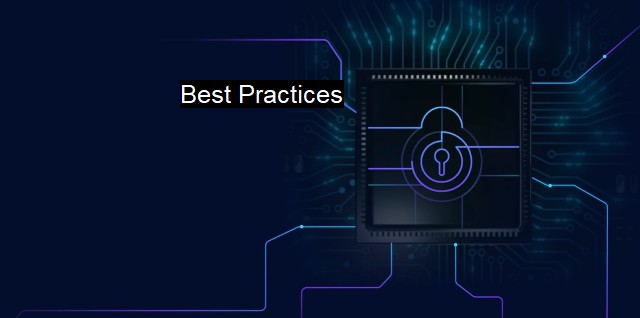What are Best Practices?
Strengthen Your Cybersecurity with Best Practices for Antivirus Installation and Configuration
Best Practices in the context of cybersecurity and antivirus refer to the comprehensive, proactive actions, steps, and procedures that an organization or individual implements to protect their information technology infrastructure, data, operations, and communications from threats, attacks, disruptions, damage or unauthorized access. The term 'Best Practices' implies that these actions and procedures are generally accepted and recognized industry standards that should be adhered to by anyone seeking to efficiently and effectively safeguard their information systems.One of the significant components of cybersecurity best practices is to identify and evaluate the organization’s vulnerable areas. Proactively identifying the weak spots in a system aids the organization's security and network administrators to determine the critical assets that need more protection. A 'critical asset' could assume numerous forms, such as a mandatory database or an essential server, or sensitive health, business, and customer data. Inventory software can be useful in tracking unsecured systems and help handle the undeniably crucial security information.
Possessing robust antivirus software also falls under the Best Practices clause in cybersecurity. Antivirus software aids in protecting systems against malware – nasty software that can do such things as corrupt systems, destroy data or allow others to access systems without authorization. It prevents, detects, and resolves these viruses and keeps the systems functioning smoothly without potential threats.
Firewalls also form a valuable aspect of cybersecurity Best Practices. A firewall aids in blocking unauthorized access in or out of a network. Utilizing a potent combination of antivirus and firewall is recommended because while antivirus software is vital for detecting known threats, it may fall short in preventing unknown or new threats. On the other hand, a strong firewall extends the boundary of system protection to the network level, automatically obstructing any suspicious activity or threats from entering the system.
Another fundamental aspect of cybersecurity Best Practices is the creation and implementation of strong, unique passwords and multi-factor authentication process. The enforcement of stringent password protocols and multifactor authentication is designed to deter unauthorized users from bypassing existing security measures. Users are encouraged to change passwords regularly and avoid using the same password for multiple accounts that may provide access to sensitive and personal data.
Real-time network monitoring also plays a crucial part in cybersecurity Best Practices. Typically, network monitoring involves oversight over computers, servers, and systems to identify slow or failing operations in real time, acting as a first-warning system for any potential attacks or invasions.
Regular updates and patches contribute significantly to the Best Practices in cybersecurity. With the help of frequent updates, it is possible to safeguard the system from current risks and eliminate susceptibilities that potential hackers may exploit.
Regular backups are a crucial component of the best practices of cybersecurity. Business data and sensitive information that may have fallen prey to cyber-attacks, accidental deletions, hardware failures, or natural disasters can be retrieved using backup data.
Last but not the least, educating all the stakeholders about basic and upgrading issues of cybersecurity helps to create a culture of awareness among them. Since exploiting unsuspecting users is one of the most common ways for threats to slip past the defenses, everyone connected to the system needs to understand the importance of cybersecurity.
To sum up, the concept of Best Practices in cybersecurity and antivirus is vital in protecting digital assets from the numerous increasing cyberthreats. Updating systems with antivirus software, firewalls, regular data backup, real-time network monitoring, robust passwords, and multi-factor authentication are examples of Best Practices, but the most effective method includes a combination of the above, and more, to establish a multi-layered security defense strategy.

Best Practices FAQs
What are the best practices for maintaining antivirus software?
The best practices for maintaining antivirus software include keeping the software up-to-date, running regular scans, and avoiding risky or suspicious online activity. It's also important to avoid disabling or uninstalling the antivirus software, as this can leave your computer vulnerable to threats.How often should I update my antivirus software?
It's generally recommended to update your antivirus software daily, as new threats can arise at any time. If your antivirus software has a feature for automatic updates, it's a good idea to enable this feature so that you don't have to remember to manually update the software.What are some common best practices for cybersecurity?
Common best practices for cybersecurity include using strong passwords, avoiding suspicious emails and links, keeping software and systems up-to-date, using antivirus software, and backing up important data regularly. It's also important to educate yourself and others on cybersecurity risks and how to avoid them.What should I do if I suspect my computer has been infected with malware?
If you suspect your computer has been infected with malware, the best course of action is to immediately disconnect from the internet and run a full antivirus scan. If the scan detects any threats, follow the recommended steps to remove the malware. It's also a good idea to change any passwords associated with important accounts, as malware can steal personal information.| | A | | | B | | | C | | | D | | | E | | | F | | | G | | | H | | | I | | | J | | | K | | | L | | | M | |
| | N | | | O | | | P | | | Q | | | R | | | S | | | T | | | U | | | V | | | W | | | X | | | Y | | | Z | |
| | 1 | | | 2 | | | 3 | | | 4 | | | 7 | | | 8 | | |||||||